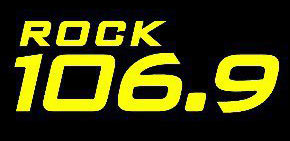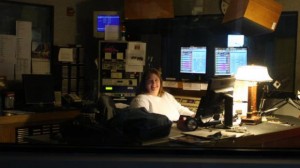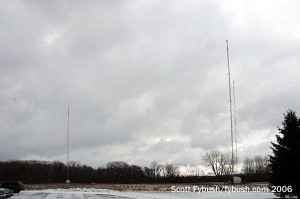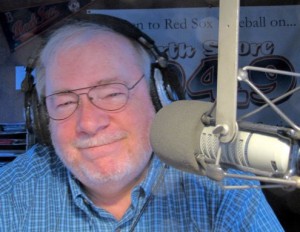NorthEast Radio Watch 12/8/2025: Cichon’s Back in Buffalo
In this week’s issue… Veteran newsman returns - Remembering NY's Leitner, RI's Jones - CT AM saved - Maine AM moves - "Indie" adds suburban signals
In this week’s issue… Hartford radio upended again – Remembering Samantha Stevens – Fight brews over new NYC TV move-in – Pennsylvania LPTV brings big bucks
By SCOTT FYBUSH
*It’s been a bad year for independent radio in CONNECTICUT‘s capital city. Hartford started 2014 with three vibrant independent competitors lined up against the big Clear Channel and CBS clusters: Buckley Broadcasting’s WDRC-FM (102.9) and its AM talk quadcast sisters, Marlin’s rocker WCCC-FM (106.9) and its classical “Beethoven” AM sister, WCCC (1290 West Hartford), and Red Wolf Broadcasting’s modern rock WMRQ (104.1 Waterbury) and its Spanish-language translator/HD sister, “La Bomba.”
 As of Friday afternoon a little past 5, as Pantera’s “Walk” faded out on WCCC-FM (hear it on our sister site FormatChange.com), the roster of independent commercial FM owners in Hartford is down to just John Fuller’s Red Wolf group, thanks to the sales of WDRC to Connoisseur and now of WCCC-FM/WCCC(AM) to EMF Broadcasting, which has flipped both signals to its national “K-Love” contemporary Christian format.
As of Friday afternoon a little past 5, as Pantera’s “Walk” faded out on WCCC-FM (hear it on our sister site FormatChange.com), the roster of independent commercial FM owners in Hartford is down to just John Fuller’s Red Wolf group, thanks to the sales of WDRC to Connoisseur and now of WCCC-FM/WCCC(AM) to EMF Broadcasting, which has flipped both signals to its national “K-Love” contemporary Christian format.
To Marlin’s credit, it gave fans and staffers of WCCC-FM a chance to say goodbye, devoting the station’s last five hours on Friday afternoon to an emotional on-air reunion hosted by Mike Karolyi and featuring many years’ worth of former WCCC’ers, including a call-in from one of the most famous, Howard Stern, who called the station home in the late 1970s.
The final hours of WCCC-FM included something else, too: plenty of ads from Connoisseur’s new classic hits version of WDRC-FM, seeking to pick up listeners who’d been attached to the more classic direction in which WCCC’s rock format had been trending over the past year or so. It’s become somewhat traditional in situations like that for the surviving competitor to at least offer a salute to the departing rival, and so it felt a little raw to a lot of listeners that WDRC’s ads instead appeared to be rubbing it in, especially after the very recent dismissal of most of WDRC’s former airstaff, replaced by voices from New Haven sister station WPLR. (Did we mention it’s been a weird year for Hartford radio?)
Connoisseur was reportedly a bidder for the WCCC stations as they were quietly shopped around over the last few months, and losing out to EMF leaves it in a challenging position: it’s all alone with WDRC-FM now (and the weak AM quadcast) against the much bigger portfolios of its corporate competitors, three big FMs and powerhouse AM WTIC (1080) for CBS, and four FMs plus an AM for Clear Channel.
For K-Love, as we noted in our Thursday update, WCCC-FM fills the gap between its existing signals in the New York area (WKLV 96.7 Port Chester, formerly a Connecticut commercial license) and in southern Rhode Island (WKIV 88.1 Westerly), and it will mark the chain’s first big urban entry into New England, traditionally a tough region for religious broadcasters. Is Hartford a sign that K-Love’s next move could be an even bigger market such as Boston? That seems unlikely, for now, because there’s not a signal available for EMF to buy there, nor in other possible expansion territories such as Providence and Worcester. (It’s not hard to imagine, though, that EMF would be right there in line with cash ready should independent outlets such as WPLM-FM or WXRV hit the market in the future.)
It’s a good bet, too, that WCCC(AM) will be for sale pretty quickly. When EMF has to buy an AM as part of a package deal, it tends to spin the AM as fast as it can. With just 490 watts by day and flea power at night, 1290’s not much of a signal, but it ought to be attractive to one of the market’s existing ethnic broadcasters.
Beyond that, there’s not much more to add to what’s been a sad week for local radio. It’s a cruel irony that as it spends hundreds of millions of dollars buying former commercial licenses, EMF can still claim financial difficulties as it asks for what will be an inevitable waiver allowing it to avoid even staffing up a main studio in Hartford. Before that can happen, Marlin and EMF have to convert what’s now an LMA into a sale; as of yet, that paperwork hasn’t been filed, and we don’t know yet how much EMF is paying for what were Marlin’s last properties.
MONDAY MORNING UPDATE – The sale contract was in fact filed on Friday with the FCC, setting the sale price for WCCC and WCCC-FM at $9.5 million. EMF will also sell the 1039 Asylum Avenue studio building, with a guaranteed payout to Marlin of at least $250,000 for the property, and it will pay $86,000 a month (plus $12,000 in music licensing fees) to Marlin for carriage of K-Love programming until the sale closes.
[private]

*Just to add to the overall depressing month in Connecticut radio, they (and we) are mourning Samantha Stevens, who died last Monday, far too young. Stevens, whose real name was Nicole Loban, was a Shelton High School and Southern Connecticut State University graduate whose post-college career included a long run at WKCI (101.3 Hamden) in the New Haven market, as well as on-air and programming stints at WEFX/WFOX (95.9 Norwalk) and the former WKHL (96.7 Stamford), a stretch as PD/middays at WEZN-FM (99.9 Bridgeport), part-time work at WEBE (107.9 Westport) and an impending gig with WRCH (100.5 New Britain), where she was to have returned to the air in September after what appeared to be a remission from cancer. She was just 44 years old.
*Now that Bob McAllen’s PMCM group has successfully launched one of its cross-country TV move-ins, Philadelphia-market KJWP (Channel 2), it had hoped to be broadcasting this week in NEW YORK City as well. But the launch of KVNV (Channel 3), the license PMCM is moving from Ely, Nevada to “Middletown Township, New Jersey,” is delayed, thanks to a complaint from Connecticut’s WFSB-TV. The Hartford CBS affiliate has been on “channel 3,” first physically and then virtually, ever since 1957, and because it counts Fairfield County as part of its home turf, it’s seen on 3 on the Cablevision systems all the way down to the New York state line. With KVNV poised to launch on RF channel 3 from 4 Times Square in Manhattan this summer, PMCM had already filed the paperwork to claim must-carry on channel 3 on Cablevision and Time Warner systems throughout the New York metro area, which threatened to displace WFSB in Fairfield County.
That would be a big blow to WFSB, whch sells local ads for a Fairfield-only custom version of its signal. So it went to the FCC asking to have KVNV forced to a different virtual channel, preferably “33,” which is WFSB’s physical RF channel (and also that of WCBS-TV in New York, but we digress.) If KVNV is moved off virtual 3, it loses the right to claim that prime “3” spot on cable, nestled neatly between WCBS and WNBC, which would dramatically reduce the new station’s visibility.
For now, the FCC (which resisted McAllen’s attempts to move the stations east in the first place until a court ruling forced its hand) is punting on the matter: at the request of Time Warner and Cablevision, it’s imposed a stay on KVNV’s channel 3 must-carry request until it can get around to ruling on WFSB’s petition to change KVNV’s virtual channel to 33. And while PMCM presses for a quick decision so it can be on the air by the time the fall ratings period starts, there’s no telling how long the virtual channel decision might take, or what appeals might slow it down. In the meantime, KVNV remains in limbo (and Connecticut viewers continue to see MeTV programming on Bridgeport’s WZME, channel 43, which will lose the affiliation once KVNV signs on.)
 *A few weeks ago, we mentioned Bridgelight’s fundraising campaign to get its new Manhattan translator built – and this week brings some new developments for that signal, W236CH (95.1 “Fort Greene”). When last we checked in, that translator was to have been a 10-watt signal from 4 Times Square, aimed mostly south, but the New Jersey-based religious broadcaster has filed an application to modify the CP. The new plan for 95.1 is to run 99 watts aimed both north and south from 4 Times Square, with deep nulls protecting co-channel WRKI in Connecticut and WZZO in Pennsylvania. The translator will relay Bridgelight’s HD4 channel on Cumulus’ WNSH (94.7 Newark).
*A few weeks ago, we mentioned Bridgelight’s fundraising campaign to get its new Manhattan translator built – and this week brings some new developments for that signal, W236CH (95.1 “Fort Greene”). When last we checked in, that translator was to have been a 10-watt signal from 4 Times Square, aimed mostly south, but the New Jersey-based religious broadcaster has filed an application to modify the CP. The new plan for 95.1 is to run 99 watts aimed both north and south from 4 Times Square, with deep nulls protecting co-channel WRKI in Connecticut and WZZO in Pennsylvania. The translator will relay Bridgelight’s HD4 channel on Cumulus’ WNSH (94.7 Newark).
*Did it seem odd to you that when Alexander Broadcasting’s WRCR (1300 Spring Valley) applied for a replacement signal on 1700, it asked to locate the 10 kW signal up north on the towers of Rockland County competitor WRKL (910 New City)? It did to us, and so it made sense last week when Alexander modified its application for 1700 to instead specify operation from the center tower of the 1300 array, on the north side of Route 59 closer to the heart of Rockland. The WRCR application calls for 10,000 watts day, 1,000 watts at night, and it claims the remaining two towers of the 1300 array will be “floated” so the 1700 signal can be non-directional from the center tower. (In real life, of course, one of those towers hasn’t existed for a while now, though there’s no STA on file with the FCC that we can find.)
NERW notes one other quirk of this highly unusual WRCR move, the path for which was greased by some friendly Congressional intervention: because the smaller 1300 signal will sign off once the new Ramapo-licensed 1700 signal signs on, the FCC is allowing the relatively rare removal of the sole licensed signal from a community, in this case Spring Valley, where 1300 has been licensed for decades.

*Near the shore of Lake Erie, WDOE (1410 Dunkirk) is joining the growing crowd of AM stations swapping out high-maintenance nighttime directional arrays for lower-powered non-directional operation augmented by an FM translator. WDOE has had the translator at 94.9 (W235BP) for a couple of years now; at the end of July, citing “safety concerns,” it dropped one of its three towers and discontinued its 500-watt nighttime operation, a tight DA that had to protect co-channel signals in Pittsburgh, Elmira and London, Ontario.
WDOE is now operating under special temporary authority with 31 watts at night, and on Friday it filed to make that move permanent, becoming a non-directional class D signal with 1000 watts by day, 31 watts at night.
*Up the road in Buffalo, WKBW-TV (Channel 7) is the lone NERW-land station affected by the big deal last week in which Scripps is acquiring Journal Broadcast’s TV and radio holdings (and then spinning off Journal’s newspapers). Since Scripps is just settling in, a few weeks after acquiring WKBW from Granite, there’s no reason to expect the Journal deal will bring any more changes at 7 Broadcast Plaza beyond the work Scripps already has to do to repair what was once the city’s top-rated station after its long fall from glory.
*It’s not just the players who move onward and upward from AAA baseball, it’s the announcers, too. Jason Benetti, who’s been calling games for the Syracuse Chiefs since 2009, is packing his bags and heading for The Show, in this case a new national radio gig calling college football and basketball at Westwood One and a yet-to-be-disclosed TV job, too. Benetti’s first Westwood One game will be Wisconsin vs. LSU at the end of August, but he’s leaving the Chiefs after this Saturday’s game. His broadcast partner Kevin Brown will handle Chiefs radio duties (on WSKO 1260) solo through the end of the season.
It took over a year, but Binghamton-market urban station WJOB-FM (93.3 Susquehanna PA) now has a full-fledged license after a long period operating under its construction permit. The Urban League of Broome County owns the noncommercial class A signal, which fills a big gap in the market that’s been lingering ever since an earlier noncommercial urban station, WUCI (91.5), came and went in the late 1980s. In addition to its main signal from just south of the state line, WJOB-FM has a CP for an on-channel booster in Binghamton, with an application pending to move the CP up to Windy Hill, near the towers of WINR (680)/WKGB (92.5 Conklin).
In Albany, Kelly Wilson (she goes by “Lynn Wilson” on the air) is gone from middays after more than a decade at Albany Broadcasting’s WYJB (95.5), where she was also handling social media duties.
Chip Morgan’s WMUD-LP (89.3 Moriah NY) lost out on its bid for a full-power noncommercial berth at 89.1 when the FCC sorted through competing applications a few years back. After the winner in that MX group, VERMONT Public Radio, signed on WOXM (89.1) over in Middlebury in April, WMUD had to move – and it’s now applying to shift to 107.3, with a site change that would move it about 650 meters north of its present site.
*Meanwhile. VPR is saying farewell to one of its most veteran on-air staffers. Neal Charnoff started as a jazz host in 1996, but he’s spent most of his time at VPR hosting All Things Considered. He’s headed for warmer weather and an earlier wakeup call after he leaves on August 15 – he’s headed to Winston-Salem, NC to host Morning Edition at WFDD (88.5).
*Jack Petersen was a staple of the AM dial around eastern MASSACHUSETTS for decades, first at WLLH (1400) in Lowell and Lawrence in the 1970s, then at WNBH (1340 New Bedford) starting in 1980, and since 1998 as a newsman and morning host across town at WBSM (1420 New Bedford). Petersen became ill in June and took what was being billed as a break from his WBSM morning duties, but pancreatic cancer tends to move quickly, and so it did with Peterson, who died Tuesday at age 70.

On the North Shore, Charlie Curtis has exited “North Shore 104.9,” WBOQ in Gloucester, where he’s been morning host and PD for nine years and a part of the station for 13 years. Curtis had a long radio career before that, including stints at WOMC in Detroit and at WPLJ, WCBS-FM and WHN in New York in the seventies and eighties. No replacement has been named yet at WBOQ.
*Quick – can you name an Erie, PENNSYLVANIA station that’s worth $2.5 million? It’s a pretty good bet that your answer, if you have one, isn’t WLEP-LD (Channel 9/RF 43). But it turns out that even if not many people are watching, low-power TV is a remarkably good business now that licensees have the opportunity to cash out in the upcoming TV spectrum auction. LocusPoint Networks is one of the companies betting big sums of money that by pulling together a big portfolio of TV licenses, it can cash out profitably when the auction finally starts. In Erie, it’s agreed to pay, yes, $2.5 million for little WLEP, which has chugged along for the last few years with a multicast of programming from Luken Communications down in Tennessee, led by the Retro TV network. WLEP’s seller is Illinois-based Hapa Media Properties.
A follow-up to last week’s speculation about the future of the Clear Channel/Premiere talk lineup in Pittsburgh: if the inside word about the imminent demise of WPGB (104.7) as a talker is true, we left out KQV (1410) as a possible landing spot for Rush Limbaugh and some of WPGB’s other star talk talent. That’s especially ironic when you remember (as we should have) that back in the 1970s, KQV was one stop along the checkered career path of a second-rate DJ named Jeff Christie, who of course eventually shed the “Christie” persona and began using his real name, Rush Limbaugh.
*Our news from CANADA starts out east in Saint John, New Brunswick, where Newcap wasted no time relaunching CHNI (88.9) after closing on its purchase from Rogers. Gone is “News 88.9,” and in its place is “Rock 88.9,” with 30 days of commercial free classic rock, leaving toward a heavier blend than most classic rockers.
When you get to the biggest market in the nation, you don’t go back to a smaller one, right? Not if you’re Carlos Benevides, who just exited middays at CFNY (102.1 the Edge) in Toronto to go back to Corus sister station CKBT (91.5 Kitchener), where he’d spent more than a decade before making his big move a few months back. Benevides is now back on the “Beat Breakfast” show, alongside Sophie Moroz and Dave Jutzi in morning drive.
In Liverpool, Nova Scotia, the CJQC Radio Society has been granted a 50-watt/-4.2 m community station on 99.3, and if you guessed that the calls of the new station will be “CJQC,” you guessed right. This isn’t actually a new station, as it turns out: a previous signal on 99.3 had been tentatively granted to Alex Walling back in 2009, but Walling never followed through on the required paperwork to demonstrate he’d properly incorporated. The CJQC folks acquired the 99.3 assets from Walling in 2012 without realizing there wasn’t a valid license to go with them, which is why they had to start the application process from scratch.
[/private]
In this week’s issue… Veteran newsman returns - Remembering NY's Leitner, RI's Jones - CT AM saved - Maine AM moves - "Indie" adds suburban signals
In this week’s issue… Scripps stations face takeover - Sinclair moves more affiliations - CT stations sold - Maine AM surrendered - Remembering WVBR's Shapiro, WABC's Morgan
In this week’s issue… CT TV legend succumbs to cancer - Remembering PA's Adams - FCC still stalled by shutdown - Pittsburgh morning host exits
In this week’s issue… FCC faces reopening challenges - Veteran Boston anchor retires - Morning shift in Toronto - NYC FMs expand reach